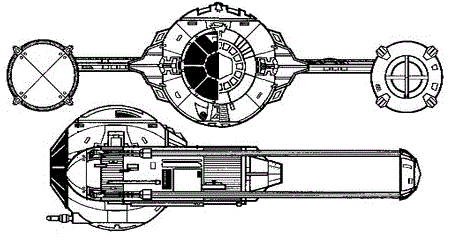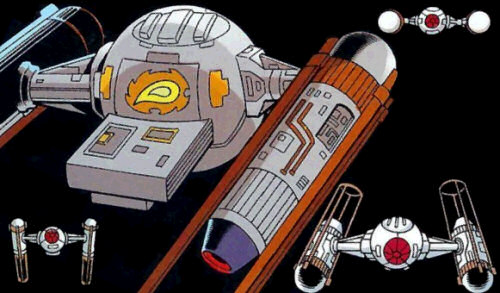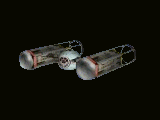
New Geh 'Dia Order. | TYE-Wing. | 
New Geh 'Dia Order. |
|---|
| TYE-Wing |
|---|
 | | TIE-Wing Schematic Half-View. |
|---|
| Production Information: |
|---|
| Manufacturer | Various |
|---|
| Product Line | Components from TIE Series and BTL Y-wing Series |
|---|
| Model | TYE-wing |
|---|
| Class | Debateably a Starfighter; Realistically a coffin. |
|---|
| Technical Specifications: |
|---|
| Length | 36 feet |
|---|
| Maximum Speed (in atmosphere) | 750 MPH |
|---|
| Engine Units | 2 Koensayr R200 Ion Jet Engines |
|---|
| Hyperdrive System | None |
|---|
| Shielding | None |
|---|
| Sensor Systems | Sienar Fleet Systems TIE Series Sensor Package |
|---|
| Armament | Sienar Fleet Systems TIE Series Laser Cannons (2) |
|---|
| Crew | Pilot (1) |
|---|
| Cargo Capacity | Up to 200 lbs |
|---|
| Consumables | Up to 2 days. |
|---|
| Usage |
|---|
| Roles | Assault Fighter (Pirate Fleets);Defense Forces |
|---|
| Eras | Rebellion Era;New Republic Era;New Geh 'Dia Order Era |
|---|
| Affiliations | Pirates;Private Defense Forces |
|---|
"Hobbie, if you can't shake a TYE-Wing, you deserve to be vaped."-Wes JANSON to Derek KLIVIAN."Save money; Throw rocks at them."
"If you really wanted to save money, you'd just yell really loud, or
call them on a radio and say mean things, and watch them fall apart."
"Mean or true?"
(slight pause) "Both I suppose."- Two REF Pilots on the TIE-Wing's "capabilities." |
DiscussionThe TYE-Wing was one of the composite Starfighter designs known as "Uglies."Though it was known by a number of names, including TIE-wing, T-wing, Y-ball, TIE-Y, TYE fighter, Die-wing, or simply TYE, it was apparently more | | TIE-Wings ("DIE-Wings"), Multiple Views. |
|---|
 | | A TIE-Wing In Action. |
|---|
standardized than most uglies.TYE-wings combined the ball cockpit and wing braces of the TIE Fighter with the engine nacelles from the Y-wing. They were armed with two TIE fighter laser cannons, usually had a functional TIE sensor package, and had fair maneuverability. Unfortunately, they had no shields, and although they were faster than many uglies, they were quite slow compared to most mass-produced fighters.The TYE-wing essentially combined the key weaknesses of both the TIE fighter and the Y-wing, yet had the strengths of neither. Many pilots dubbed them "DIE-wings", as the survival rate of TYE-Wing pilots was appallingly low.TYE-wings were often found in the service of pirates, notably Kavil's Corsairs and others under the Blazing Claw sigil. They were also found in many private defensive fleets. Some were used by the Imperial Remnant. Few will risk valuable PILOTS in these craft (keeping in mind that most groups that use the TYE-Wing treat life as short, cheap, and even the best pilots as 'disposable').Most groups that do both with these pieces of crap use them as sentries and missiles/flying bombs (using TIE/D fighter pods instead of 'true' TIE pods). So inferior is the design, that a Kobolese Defense Forces Raider once disabled one with her RADAR; During a routine scan at relatively close range, the Raider scanned the TIE-Wing, overloading every electrical circuit onboard and causing it to drift. The Raider, thoroughly confused, took station on observation (though she kept he guns trained on the TIE-wing throughout) until a KDF shuttle arrived and took the fighter in tow; The TIE-Wing was rigged as a suicide bomb, but with the electrical systems thoroughly trashed the pilot couldn't get the bomb to explode, and expecting not to return, hadn't even brought a gun, and thus was taken alive and relatively unharmed.DeploymentThe TIE-Wing is really not in service in any numbers; The few people who do use them either throw them away quickly, or die. They're worth more for their recycle value; These are so utterly worthless, the black market can't even produce them; The REF owns a small wing (8 ships) for training Flight Officer Candidates, but the rest of them are home-builds for personal intrest.REF-Era EmploymentPlayers should be familiar with this system; Every so often a group will use these as tertiary perimeter markers/mines to defend territory they hold. A few successful pirate groups have used these as starter platforms, usually targeting minor recreational craft (which are usually unarmed or very lightly so).The TYE-Wing's main weakness are a lack of shields, light and restricted armament, limited armor, lack of speed, limited maneuverability, poor fuel economy, and generally that they exist. The advantages of the TYE-Wing is you could build one in an old barn with a blowtorch, English wheel, plate metal, and mail-order fusial engine and grav pods (about 20,000credit; 4-8 weeks for delivery on average).Vehicle Type: Aero-Space Fighter/Attacker/Tactical Reconnaissance.Crew: One or two.M.D.C By Location: |
Fuselage-
Engines (02)- | 100
50 each | Reinforced Pilots Cockpit-
| 50
|
| Note: Usual conditions applySpeed and Statistical Data: |
Driving on the Ground: 1/2 mph for a few miles; Taxi only.
In Atmosphere and Space: 300 mph (XXkph)
Maximum Range: 60,000 miles.
Length: 36 feet (XXm)
Height: 27 feet (XX meters)
Width: 13 feet 6 inches (XX meters). | Weight:.2 tons (XX metric tons) unloaded
Power System: Various fusion powerplant.
Cargo: Small storage space.
Cost and Availability: A few hundred credits to build; Can be built at home if you can get the grav pods and powerplants (moderately difficult).
|
| Weapons Systems: |
|---|
1. 2 times SFS L-s9.3 Chin-Mounted Medium Laser Cannons: Mounted on the "chin" of the fighter and fire directly forward. Can be fired in tandem or paired; Each individual blast must be rolled as an individual strike, making tandem the most power to target (but only one roll to strike) and paired not as powerful but more likely to strike. Each blast must be rolled and applied as an individual strike.
| MD: 3D6 per cannon.
Range: 12,000 feet (3,600 m) in an atmosphere and 32,000 feet (9,600 m) in space.
Rate of Fire: Each squeeze of the trigger is counted as one attack, but the guns fire according to the setting.
Payload: Effectively Unlimited. |
| Features: |
- E.S.M.: Radar Detector. Passively detects other radars being operated.
- Radar: Combat grade radar. Range 100 miles, can track up to 50 individual targets. 95% reliability (24% against unfriendly stealthed vehicles).
- Blue Force Tracker: Identifies friend from foe. Overlays the information on both the radar and HUD, ensuring that friendly forces are not accidentally targeted.
- GPS: Standard tracking device. Ties into the Blue Force Tracker.
- Anti-Jamming System: Reduces Electronics Countermeasure by 3/4 (decrease skill level appropriately).
- HUD: Displays maps, radar, targeting information, and any OTHER information the wearer wants directly in front of the user.
- FLIR/SLIR: Forward and Side Looking Infrared. Allows pilot to get visuals on targets at night.
- AJP: Active Jamming Pod. Causes -25% to detection but when it is active, other vehicles/bases can detect that it is jamming, and some missiles will home in on jamming signals. Jamming also causes a -4 penalty to all radar guided weapons. The jamming pod is only mounted inside the port taileron.
- Oxygen Rebreather System: Extends pilots air supply to 100 hours; Cartridge MUST be replaced after that period of time.
- Magnetic Clamps: Electro magnets in the pads of the landing struts allow the fighter to adhere to the hulls of Warships and the exteriors of SOME buildings.
- Combat/Targeting Computer: Records all enemy and friendly activity over the course of time; Can replay that activity for the pilot, assign target designation numbers, and track likely damage based on mathematical formulas (i.e. "Right leg red" badly damaged/destroyed, "head green" not damaged, etc). Displays this information as a pop up in the HUD on request by the pilot.
- Full Range Sensory Systems: Infrared, Ultra Violet, Color Filters, and Thermal Imager: Range: 10 miles; Magnification: 40 times
- Virtual Map: Displays a continuously-updating map of local terrain for the pilot. Takes data from other friendly units in the area. Effective land navigation of 85% as updates come. Good to 500 miles. Specific range can be adjusted in 100 mile increments.
- Video Camera: Records from the HUD and HDD. 50 hours of recording available.
- MRA 6 Radios: Allows real time, continuous radio link up with friendly forces in the area via satellite relay over laser radio signals, preventing jamming, and automatically encrypts/decrypts same to prevent eavesdropping.
| - Type-11 wide band radios: Effective 10 mile range, auto encrypt/decrypt. Works on standard radio band wavelengths, so it can still be jammed (if the enemy knows the frequencies).
- Towed XTNDR RADAR/Radio Antenna Extender: A simple 10 lb. pod is towed 100 feet behind the fighter. A fiber-optic cable relays the data collected from the XTNDR Pod to the fighter's computers.
- M.D.C. By Location:
- Pod: 50
- Fiber Optic Cable: 10
- Effect: Extends range of any sensors 10 times (or defeats other penalties in a 5 mile area).
- Decoys: Despite the relative commonality of the Launched/Towed Decoy Pods and Anti-Missile Chaff/Flare Dispenser systems, the simpler Decoys originally used on the Starfighter is the one still in use. The reason they have not been switched out for the more effective L/TDP and AMC/FD systems is the Steinerian sense of superiority; However, privately owned combat ready craft have been retro-fitted to the better system. The decoys themselves are specially modified Mini-Missiles that produce burning globs of magnesium/aluminum alloy to confuse both radar AND heat sensory systems, as well as creating a lot of smoke to obscure the fighter. Note: Though the modified mini-missiles combine smoke flares, AMC/FDs, and LDP's, they aren't powerful enough for use with Destroids/Guardians/Etc. Reduce effects by 20% against smart missiles (add +20% to rolls for smart missiles).
- Effect:
- 01-50: Enemy missile or missile volley detonates in chaff cloud-
- Missiles are all destroyed.
- 51-75: Enemy missile or missile volley loses track of real target and veers away in wrong direction (may lock onto another target).
- 76-00: No effect, missile is still on target.
- Also note that the chaff cloud will also blind nearby heat sensors (and optically based sensors at night) for 1 melee. They will suffer the following penalties: Reduce melee attacks/actions, and combat bonuses by half. Also, a cloud of smoke approximately 25Square feet.
- Duration: 1D4 melee rounds.
- Rate of Fire: Once per melee.
- Payload: 6 chaff/flares.
- Survival Pack: A pack of simpler emergency survival supplies.
|
Combat Bonuses From TYE-Wing Fighter Combat Elite:- None. It's a crap fighter.
- No experience points for destroying a TIE-Wing. Players can get XP for disabling them with a called shot, or some other shenanigans, at GM's discretion, but destroying one isn't even XP worthy.
| Combat Profile For Automated TYE-Wing Fighter:- None. It's still crap.
- NEGATIVE experience points for destroying a TIE-Wing unless some other shenanigans were involved (again at GM's discretion). This is the dogfighter equivalent of kicking a puppy. Shame on you.
|




